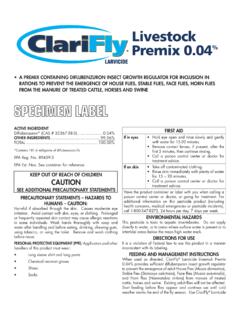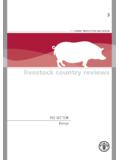Transcription of GUIDANCE DOCUMENT ON CROP FIELD TRIALS - OECD
1 20110118_GD 1 This DOCUMENT is a draft GUIDANCE DOCUMENT on Crop FIELD TRIALS , developed by the Residue Chemistry Expert group of the Working Group on Pesticides. It has been revised further to comments received from the Registration Steering Group, a sub-group of the Working Group on Pesticides. It is circulated for comments by 25 March 2011 to the Working Group on Pesticides and the Working Group of National Coordinators of the Test Guideline Programme. Please send any comments to Sylvie Poret 20110118_GD 2 GUIDANCE DOCUMENT ON CROP FIELD TRIALS Version 5 (15th January 2011) Introduction 1. Crop FIELD TRIALS (also referred to as supervised FIELD TRIALS ) are conducted to determine the magnitude of the pesticide residue in or on raw agricultural commodities, including feed items, and should be designed to reflect pesticide use patterns that lead to the highest possible residues.
2 Objectives of crop FIELD TRIALS are (1) to quantify the expected range of residue(s) in crop commodities following treatment according to the proposed or established good agricultural practice (GAP); (2) to determine, when appropriate, the rate of decline of the residue(s) of plant protection product(s) on commodities of interest; (3) to determine residue values such as the Supervised Trial Median Residue (STMR) and Highest Residue (HR) for conducting dietary risk assessment and calculation of the dietary burden of livestock; and (4) to derive maximum residue limits (MRLs).
3 The purpose of these TRIALS is described in the OECD Guideline on Crop FIELD TRIALS . While the OECD Guideline on Crop FIELD TRIALS provides a harmonized approach to conducting and reporting crop FIELD TRIALS in OECD countries this GUIDANCE DOCUMENT on Crop FIELD TRIALS will help in planning the TRIALS in OECD countries and in interpreting the results. 2. The DOCUMENT will discuss some aspects that need to be considered while evaluating crop FIELD TRIALS . Topics include: Principles of crop grouping and selection of appropriate representative crops as a prerequisite for extrapolation of results from residue TRIALS used in national/regional approaches as well as in Codex.
4 Proportionality, the relationship between application rate and resulting residues. Equivalency of formulations. Use of conversion factors that enable conversion of residues measured using the definition for residue enforcement to the equivalent residue using the definition for risk assessment. Conversion of residues in whole commodity to the residue in edible parts of the commodity. Geographical distribution of residue TRIALS . The number of residue TRIALS required using national/regional approaches, the Codex approach and comprehensive data submissions in OECD countries. The selection of residue data for MRL determination.
5 The Use of the OECD MRL Calculator. Crop Grouping Background 3. National authorities use targeted data sets and data extrapolation to provide sufficient data for exposure assessment or for setting MRLs for both individual major and minor crop commodities, and crop commodity groups. Data extrapolation provides the mechanism for extending FIELD trial data from several (typically two or three) representative crop commodities to related crop commodities in the same crop group or subgroup. Crop grouping and the identification of representative crop commodities are also critical for maximizing the applicability of a targeted data set determined for representative crop commodities for minor uses.
6 The representative crop commodity (within the group) has the following properties: 20110118_GD 3 (1) major in terms of production and consumption and (2) most likely to contain highest residue. 4. Representative crops are those designated crops from which extrapolations of MRLs/tolerances can be made to one or more related crops or to an entire group of crops. Crop group schemes are intended to classify commodities into groups and subgroups that have similar characteristics and residue potential (Codex Alimentarius Commission, 1999). For example, the Codex pome fruit group contains apple, pear, crabapple, Japanese medlar, loquat, medlar, nashi pear, quince, and oriental pear.
7 As an example for representative crops apple and pear would be suitable. 5. One use of the crop group is to establish a maximum residue limit (MRL, tolerance) for the entire group based on FIELD trial data for several of the commodities, designated representative commodities, within the group. In the pome fruit group, residue data for apples and/or pears would be used to establish a MRL for pome fruit. This MRL would apply to all members of the group provided the GAP is comparable within the crop group. 6. The classification systems in North American Free Trade Agreement (NAFTA), European Union (EU), and Codex are currently under revision and expansion.
8 NAFTA system is being revised and expanded based on petitions to EPA from Interregional Research Project No. 4 (IR4). IR4 creates the petitions based on work with the International Crop Grouping Consulting Committee (ICGCC), USDA, and EPA/OPP. The ICGCC is a voluntary association of international experts with interests in plant physiology, residue research, regulation, and the growth/export/import of minor crops. Simultaneously, Codex via a CCPR workgroup chaired by the Netherlands is working on the revision of the Codex Classification of Foods and Feeds. The work of the ICGCC/IR4/EPA is being used as a basis for this revision.
9 7. The OECD Pesticide Residue Chemistry Expert Group (RCEG) will consider adoption of the groups as they become available at Step 7 in the Codex process. 8. This paper describes the current situation and contains a table of the groups, subgroups, representative commodities, and extrapolations in Codex, EU, Australia, Japan, and NAFTA (Appendix 1). 9. Like the EU, Codex will include crop and commodity codes to facilitate proper identification of crops/commodities. Note that in the classification there will be crops with multiple commodities (radish root and tops), and these commodities are in different classification groups.
10 It may also happen, that one commodity belongs to different (sub) groups, blueberries (low bush) and blueberries (high bush) where agricultural practice differ. If different MRLs are established for the (sub) groups, the higher level would prevail for enforcement purposes on blueberries. 10. Crop grouping in this GUIDANCE DOCUMENT will emphasize the criteria for classification, issues related to representative crops, and opportunities for additional extrapolations. GUIDANCE will be provided on the use and combination of data sets for crop group MRLs. Principles for Crop Grouping National/Regional Approaches to Crop Groups 11.












